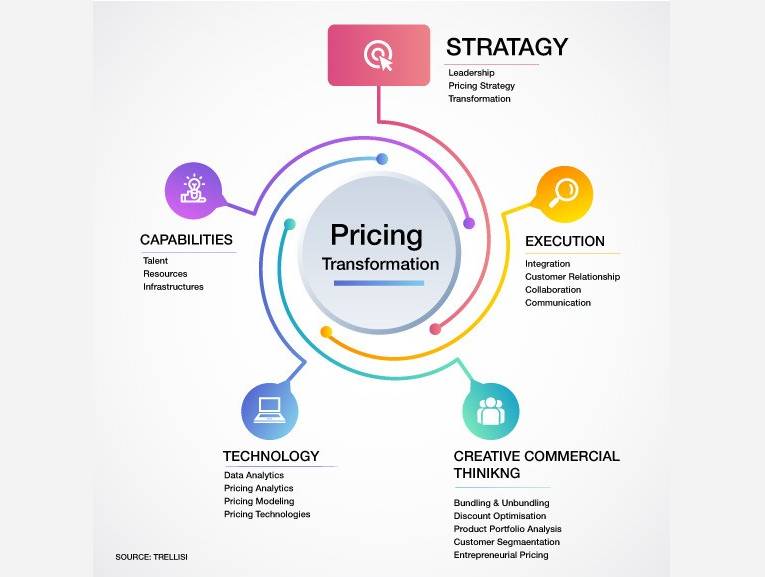Tunde
How to build a loyal community online and offline
Back
Resource
Date: 25 Jan 2021
By Trellisi
Business Research
Whether retailers choose to fight it or flow with it, the disruptions of the past 18 months have created lasting change. In a recent conversation with Ad Age, Mike Menkes, SVP at Analytic Partners, and Jennifer Lee-Harrison, VP of demand generation at Carter’s Inc., discussed how the retailer is navigating these changes by using analytics to make smarter business decisions and future-proof for success. Access your copy of the video to learn more about:
- What best practices to keep in mind to adapt to changing consumer behavior
- How to build a culture of change within an organization
- How to design the right analytics framework to gain meaningful insights
- And more
Fill out the below form to attend future events.
Let's transform your business for growth
Discover how Trellisi can get your data, pricing and analytics unstuck.
Contact us Today
PARTNER WITH TRELLISI
Let's Help You Transform for
Growth and Accelerate Impact
Trellisi's machine learning expertise has been instrumental in helping our team gain deeper insight into customer behaviour and preferences. This has enabled us to provide more personalised recommendations and create an even better customer experience. We've seen a marked increase in average transaction value, largely driven by the exceptional precision and power of the solution provided. We're excited to continue leveraging Trellisi's expertise to further our progress!
SVP Marketing - Technology Services
"We teamed up with Trellisi to support our business model and pricing strategy transformation. With their modelling and analytics expertise, we were able to evaluate various pricing options and GTM scenarios and their impacts in a meaningful way. Their insights and crucial challenges provided us with critical feedback and guidance throughout the entire process.
CFO - Private Equity Portco
“The Trellisi team pulled together tons of data to cleanse, analyse and map the customer journey. The insights and new KPIs helped us prioritise actions and track performance as we improved processes to simplify the customer journey.
Ops Director - Retail Services
Call us On +44 (0)208 004 3015
Latest News
Trellisi Insights
Caring is the new marketing
Back
Resource
Date: 25 Jan 2021
By Trellisi
Business Research
Whether retailers choose to fight it or flow with it, the disruptions of the past 18 months have created lasting change. In a recent conversation with Ad Age, Mike Menkes, SVP at Analytic Partners, and Jennifer Lee-Harrison, VP of demand generation at Carter’s Inc., discussed how the retailer is navigating these changes by using analytics to make smarter business decisions and future-proof for success. Access your copy of the video to learn more about:
- What best practices to keep in mind to adapt to changing consumer behavior
- How to build a culture of change within an organization
- How to design the right analytics framework to gain meaningful insights
- And more
Fill out the below form to attend future events.
Let's transform your business for growth
Discover how Trellisi can get your data, pricing and analytics unstuck.
Contact us Today
PARTNER WITH TRELLISI
Let's Help You Transform for
Growth and Accelerate Impact
Trellisi's machine learning expertise has been instrumental in helping our team gain deeper insight into customer behaviour and preferences. This has enabled us to provide more personalised recommendations and create an even better customer experience. We've seen a marked increase in average transaction value, largely driven by the exceptional precision and power of the solution provided. We're excited to continue leveraging Trellisi's expertise to further our progress!
SVP Marketing - Technology Services
"We teamed up with Trellisi to support our business model and pricing strategy transformation. With their modelling and analytics expertise, we were able to evaluate various pricing options and GTM scenarios and their impacts in a meaningful way. Their insights and crucial challenges provided us with critical feedback and guidance throughout the entire process.
CFO - Private Equity Portco
“The Trellisi team pulled together tons of data to cleanse, analyse and map the customer journey. The insights and new KPIs helped us prioritise actions and track performance as we improved processes to simplify the customer journey.
Ops Director - Retail Services
Call us On +44 (0)208 004 3015
Latest News
Trellisi Insights
Helping a local business reinvent itself
Back
Resource
Date: 25 Jan 2021
byTrellisi
Business Research
Whether retailers choose to fight it or flow with it, the disruptions of the past 18 months have created lasting change. In a recent conversation with Ad Age, Mike Menkes, SVP at Analytic Partners, and Jennifer Lee-Harrison, VP of demand generation at Carter’s Inc., discussed how the retailer is navigating these changes by using analytics to make smarter business decisions and future-proof for success. Access your copy of the video to learn more about:
- What best practices to keep in mind to adapt to changing consumer behavior
- How to build a culture of change within an organization
- How to design the right analytics framework to gain meaningful insights
- And more
Fill out the below form to attend future events.
Let's transform your business for growth
Discover how Trellisi can get your data, pricing and analytics unstuck.
Contact us Today
PARTNER WITH TRELLISI
Let's Help You Transform for
Growth and Accelerate Impact
Trellisi's machine learning expertise has been instrumental in helping our team gain deeper insight into customer behaviour and preferences. This has enabled us to provide more personalised recommendations and create an even better customer experience. We've seen a marked increase in average transaction value, largely driven by the exceptional precision and power of the solution provided. We're excited to continue leveraging Trellisi's expertise to further our progress!
SVP Marketing - Technology Services
"We teamed up with Trellisi to support our business model and pricing strategy transformation. With their modelling and analytics expertise, we were able to evaluate various pricing options and GTM scenarios and their impacts in a meaningful way. Their insights and crucial challenges provided us with critical feedback and guidance throughout the entire process.
CFO - Private Equity Portco
“The Trellisi team pulled together tons of data to cleanse, analyse and map the customer journey. The insights and new KPIs helped us prioritise actions and track performance as we improved processes to simplify the customer journey.
Ops Director - Retail Services
Call us On +44 (0)208 004 3015
Latest News
Trellisi Insights
Why do you need to define a data strategy before making any investment in technology?
Back
Articles
Date: 13 May 2022
#Data Strategy
#Data Governance
Strategy should always come first. So why do so many data projects begin without a clear vision of the big picture? Why do so many organisations invest in technology solutions before they have a clear understanding of what they want to do with their data?
A data project shouldn’t be any different to any other organisational investment. And the fact that any technology investment should be rooted in your organisational strategy isn’t a controversial idea. After all, all business investment ought to be driven by a clear strategic vision – so that expenditure is aligned with organisational business plan in a way that will deliver on the stated organisational goals.
So, why then, do so many organisations fail to develop a coherent data strategy before spending money on their data projects?
Perhaps it is fear or a lack of understanding: data science is often presented as some sort of “dark art” rather than the methodological science it is. Or perhaps it is a desire to “get started” quickly – commentators often advocate an agile approach to data projects without recognising that there must first be a strategic vision behind agile methodology.
Whatever the truth, the strategic vision must come first.
Why do you need to define a data strategy first?
Let’s consider the risks to your organisation if strategy doesn’t precede investment.
1. Collecting and keeping data beyond purposeful need
Information overload is a real problem for many organisations. The sheer weight of data generated by today’s digital world presents significant challenges. First and foremost, there is the cost of data storage which can easily get out of hand if not properly managed. However, storage costs pale into significance when we consider the cost of compliance. There are the practical responsibilities of information management, such as responding to data subject access requests. Added to this, organisations must manage the cyber security risks. Failing to fulfil these requirements or falling foul of compliance rules can be very costly indeed. The best way to mitigate all of these obligations and risks is to reduce the data your organisation holds to an absolute minimum. This requires a clear understanding of what data you need to hold and why – in other words, a coherent data strategy.
2. Creating more siloes of information, rather than fewer
Given that breaking down siloes of information is frequently cited as a key organisational objective, it’s really important that your data efforts are well targeted. We’ve seen numerous data projects which have ended up creating just another silo of information – exacerbating, rather than solving, the problem.
Without positioning your efforts within your overall goals and acting with clear strategic intent, you risk making your data problems worse – rather than better.
3. Legacy or unscalable architecture that makes future analysis more difficult
There can sometimes be a tendency to view data architecture as a tactical exercise, rather than something you should consider upfront. However, there are always some important architecture decisions which will need to be taken early on. For this reason, it’s worth involving data architects in your visioning and strategic planning processes.
This way, you can develop architecture principles at an enterprise level. These can then be filtered down throughout the organisation, across all data projects. As long as these principles are sound – and adhered to – you can avoid many practical problems. When you allow individual projects to go off and do their own thing, that’s when you run into problems. Avoid this by taking a strategic approach early on.
4. Unfocused action and investment decisions
How can you properly prioritise projects when you aren’t clear on the overall objective? What criteria are you measuring those individual projects against? While you might have a real desire to get started and an eagerness to deliver practical results quickly, you’re just wasting time if you get started on the wrong thing.
This is especially true in organisations in which an agile approach is advocated. While we are big fans of agile methodology, we also recognise that it can sometimes be used to justify a scattergun or ill-planned approach to projects. While early proof-of-concepts that demonstrate measurable value and return on investment are important to ensure success, these proof-of-concept projects should be carefully chosen within the broader context of your strategic vision.
If you aren’t strategic in your choice of and approach to projects, then you cannot be certain that your efforts are truly targeted on what the organisation wants to achieve.
If you aren’t strategic in your choice of and approach to projects, then you cannot be certain that your efforts are truly targeted on what the organisation wants to achieve.
5. Choosing the wrong technology
Given the number of technology vendors pitching in this space, it is unsurprising that business leaders are often tempted to lead with the technology. However, this would be a mistake.
Technology isn’t the difficult part of a data science project – there are usually several solutions that will meet any need. However, if you invest first and ask questions later, a poorly thought-through technology decision can soon become a burden.
In a strategic approach, you should consider which questions you want answers to first. You have to do this before looking around at how you might answer the questions. Or how to present the answers to the people who need them. Otherwise, you can easily end up with some fantastic new software with sleek features and interfaces but with yet-unknown functional incompatibilities that is doomed to become, over time, yet another siloed system.
The importance of a clear, strategic vision
Strategy must come first:
- What are the organisational objectives? What is the organisation’s purpose? What do you want to do (differently)?
- What insights do you need in order to achieve this?
- How do we construct a data architecture that provides these insights?
Tactical decisions about:
- which projects to prioritise,
- which data to store,
- which data can be defensibly deleted,
- which technology you might need to invest in,
- how to present which data to whom
will all follow from your early strategic work.
Have you defined your organisational data strategy?
If you haven’t yet done the early work to define your organisational strategy, it’s not too late – and our team is on hand to assist.
If you’d like help with strategic thinking or wish to discuss any of the ideas raised in this article, please get in touch.
You can reach us on: 0208 004 3015
Or email us at: connect@trellisi.com
Table of Content
What are the risks to your organisation if strategy doesn’t precede investment
Collecting and keeping data beyond purposeful need
Creating more siloes of information, rather than fewer
Legacy or unscalable architecture that makes future analysis more difficult
Unfocused action and investment decisions
Have you defined your organisational data strategy?
Start Your Journey
Transform Intelligence into Impact
"The Trellisi team expertly mapped our customer journey, providing crucial insights and actionable KPIs. Their insights enabled prioritised actions to drive performance improvements and enhance customer experience."
Retail Services - Operations Director
"We teamed up with Trellisi to support our business model and pricing transformation. Their analytics expertise enabled us to evaluate pricing options and GTM scenarios with confidence, providingcrucial guidance throughout the process."
Private Equity Portfolio Company - CFO
"Trellisi's machine learning solutions delivered deeper customer insights, enabling personalised recommendations and direct increases in transaction value through precise analytics."
Technology Services - SVP Marketing

Latest News
Trellisi Insights
Pricing Transformation: Why it Matters and How to Implement it
Back
Articles
Date: Nov 2022
by Tayo Korede PhD and Tunde Oloruntoba
Pricing transformation offers an opportunity for companies to rethink their pricing strategy and unlock new avenues for growth, profit and competitiveness.
Pricing strategy is a core management function. It requires organisations to constantly change and adapt their pricing for profit and sustainability. Pricing is complicated – especially when managers are required to respond swiftly to changes in the business environment, perhaps due to crisis or disruption such as the pandemic and the ongoing war in Ukraine. To realise the full potential of products and services, organisations must adapt their price offerings to meet the changing and ever-challenging market.
Pricing transformation is a reinvention of the pricing framework to enable an effective pricing decision–making process which unlocks new opportunities, generates new value and improves profit and growth. It is more than just making a minor change or improvement here and there; it is a fundamental change in pricing logic. It can unlock new avenues for sustained growth and profitability. By deploying an overarching competitive pricing model organisations can improve margins and profits.
1. Why pricing transformation matters

Businesses embarking on pricing transformation must recognise that pricing is complex, and transforming it requires a clear focus and steadfast discipline to change management principles to achieve the desired outcomes.
When done right, pricing transformation provides significant benefits, including:
- Enhance price optimisation.By figuring out the right balance between value and profit, companies can identify the pricing sweet spot based on market insight and variation in demand. Thus, businesses can attract and retain customers, maximise sales and increase profits
- Ensure price differentiation. Product and services do not command generic value. Through pricing transformation, companies can develop offers that appeal to different market segment and monetise value.
- Improve profitability and sustainability. Profitability and sustainability are not mutually exclusive. Pricing transformation delivers super value which improves profit and sustains
- Provide predictive pricing. Dynamic pricing through strategy and predictive analytics unlocks opportunities by anticipating changes. It turns changes in customer behaviour to pricing power.
- Improve value proposition. Good pricing transformation articulates a strong and compelling value proposition which is key to competitive advantage.
- Enhance customer understanding and engagement. Pricing transformation provides ongoing interactions with customers. This generates valuable customer insight and improves customer loyalty and trust.
- Personalise pricing to customers. The tailored pricing of products and services enabled by technology can drive growth and revenue. Extracting value from products and services through pricing transformation is not an easy task. A “quick fix” mindset to pricing does not maximize profit or resolve your pricing issues.
2. How to implement pricing transformation

Pricing transformation can mean different things to different organisations. There is no perfect model or template which all organisations can adopt.
Extracting value from products and services through pricing transformation is not an easy task. A “quick fix” mindset to pricing does not maximise profit or resolve your pricing issues.
But after researching different models and approaches to pricing transformation across various organisations and industries, we've developed a pricing transformation framework which organisations can adopt and adapt. It can be applied to your own unique goals and circumstances. It offers clarity on how businesses can implement pricing transformation by providing insightful elements and listing important factors that you may find useful when rethinking your pricing strategies to maximise profits.
The pricing transformation framework is a blend of five major components: strategy, capabilities, creative commercial thinking, technology and execution.
Creative pricing impacts positively on company profits, creates value for customers and ensures sustained growth. Yet, business managers tend to focus on product innovation while neglecting pricing innovation. By thinking differently about pricing, businesses can generate superior value through a blend of discount optimisation, bundling and unbundling, product portfolio analysis, customer needs segmentation and paradigm shift in pricing thinking.
STRATEGY
Pricing is more than an element of the marketing strategy. It is a strategic organisational capability. At an organisational level, pricing transformation can be a source of competitive advantage. As such, leadership is an important factor in achieving pricing transformation. Business leaders should not be passive when it comes to pricing strategy. To be effective, they need to lead and incorporate pricing as a key part of corporate strategy. Pricing transformation becomes difficult to achieve when business leaders are indifferent or take pricing for granted.
Research in pricing and strategy has shown that upper-management involvement in pricing strategy significantly improves pricing capabilities and firm performance, leading to increased company profit. For example, the involvement of CEOs in the pricing function positively influences profit margin, market share and competitive positioning (1). Yet only 22% of Fortune 500 companies and 15% of top 500 US firms invest in strategic pricing capabilities (2).
Pricing is fundamental to a strategic CEO’s job. Developing pricing strategy and building pricing capability are part of the executive leadership responsibility. Strategy, not just technology, drives pricing transformation.
CAPABILITIES
Implementing pricing transformation requires investment in talent, resources and infrastructure. Without the right talent competencies and resources, companies will be unable to effectively implement their pricing transformation agenda.
Companies require employees with skills and competencies to drive pricing change. Some of the skills and competencies required involves restructuring the processes used in pricing decisions, equipping those making pricing decisions with the right information, and reworking the pricing model and architecture to ensure pricing strategy aligns with corporate objectives. Empowered employees can capture opportunities that pricing transformation creates.
People make technology and transformation work. If the right talent is absent, organizations should consider recruiting digital and data talent or seeking external support to enable the pricing transformation. Pricing training programmers and internal communication will provide support and insight to plan and effectively manage the transformation process.
Investment in key infrastructure is also critical to pricing transformation. It provides the right architecture for implementing pricing transformation.
CREATIVE COMMERCIAL THINKING
Pricing is often the least creative element of the marketing plan for many organisations. However, the days of traditional and reactive approaches to pricing are over. Creative and entrepreneurial orientation to pricing enables companies to navigate disruptive business environments. Creative pricing impacts positively on company profits, creates value for customers and ensures sustained growth. Yet, business managers tend to focus on product innovation while neglecting pricing innovation. By thinking differently about pricing, businesses can generate superior value through a blend of discount optimisation, bundling and unbundling, product portfolio analysis, customer needs segmentation and paradigm shift in pricing thinking.
Innovative companies tend to adopt a variety of pricing strategies across their product and service portfolio. Pricing transformation helps to inform these strategies, including preventing price leakage by enabling discount optimisation.
Importantly, by combining pricing transformation with customer segmentation and product portfolio analysis, businesses can package or unpackage their products to unlock value and increase profit. Product bundling offers complementary products to offer additional customer value and enhance customer satisfaction. By contrast, unbundling provides choice and flexibility. Businesses can avoid head-to-head competition through innovative product bundling and unbundling. By bundling product offerings and grouping customers into different segments based on their needs it is possible to improve pricing tactics by providing each customer group with distinct price points based on their needs. However, traditional customer segmentation based on demographics alone is not enough to support optimal pricing strategy and profitable growth. Dynamic pricing based on value-based segmentation through data analytics offers more promising potential for growth and profitability.
We advocate an entrepreneurial approach to pricing. Entrepreneurial pricing is opportunity-seeking, embraces risk and is proactive, flexible and innovative. Such entrepreneurial pricing may involve usage-based pricing, risk-based pricing, value-based pricing, point-based pricing, environmental-based pricing, etc.
TECHNOLOGY
Pricing technology plays an important role in pricing transformation as it helps to automate pricing processes and activities, allowing companies to quickly and accurately adjust prices to meet changing market conditions. Of course, technology won't solve all your pricing problems, but technology will facilitate your pricing transformation strategy.
Pricing and data technology tools such as CPQ, PMS, and BI solutions provide data-driven insights that can help companies optimise their pricing strategy and stay competitive. These technology solutions provide advanced analytical backbone fit for today's dynamic and competitive marketplace.
Additionally, pricing technology can help companies identify opportunities to increase profits, reduce costs, and improve customer loyalty through personalised pricing. With pricing technology, organisations can streamline the pricing process, automate pricing activities, and gain real-time insights into customer data to optimise pricing decisions.
Moreover, the adoption of artificial intelligence and data analytics in pricing transformation can help companies to make more informed pricing decisions. By using AI and analytics to interpret data, businesses can identify trends and preferences that were previously undetectable. This information can then be used to adjust prices in response to changing market conditions.
EXECUTION
Often, the real challenge of pricing transformation is execution. Execution is a known weakness in any transformation agenda. Research suggests that about 60% of transformation strategies are not implemented successfully. While the execution of pricing transformation may be process-based and system driven, important components to consider include integration and alignment with corporate strategy, customer involvement and carrying customers along, collaboration and your communication strategy.
Pricing should be a conversation. It becomes effective through collaboration and communication with stakeholders. Collaboration is of huge importance in a fast-paced and competitive market environment. Businesses that want to capture value must co-produce value through constant engagement with their customers and suppliers. Customer interaction and collaboration provide not only customer insight but also competitor insight. Clear, open and transparent communication through a cohesive communication strategy is critical to the implementation of pricing transformation.
Our team @Trellisi.com is here to support you
Pricing transformation is a complex process for many organisations, and understanding the different dynamics of pricing can be challenging. However, with the right guidance and expertise, organisations can successfully navigate the process and reap outsized benefits.
Want to transform your pricing or set a new pricing strategy but not sure where to start? We can help.
How we support you:
- Diagnostics and discovery
- Modelling and analytics
- Monetisation and strategy
- Execution and monitoring
Contact us today at: connect@trellisi.com to get the conversation started
References
- Hinterhuber, A. & Liozu, S.M. (2013). Innovation in pricing: Contemporary theories and best pratices. New York: Routledge
- Liozu S.M. & Hinterhuber, A. (2021). pricing and CEOs: why top executives need to get involved. journal of Business Strategy.
Table of Content
Why pricing transformation matters
How to implement pricing transformation
Start Your Journey
Transform Intelligence into Impact
"The Trellisi team expertly mapped our customer journey, providing crucial insights and actionable KPIs. Their insights enabled prioritised actions to drive performance improvements and enhance customer experience."
Retail Services - Operations Director
"We teamed up with Trellisi to support our business model and pricing transformation. Their analytics expertise enabled us to evaluate pricing options and GTM scenarios with confidence, providingcrucial guidance throughout the process."
Private Equity Portfolio Company - CFO
"Trellisi's machine learning solutions delivered deeper customer insights, enabling personalised recommendations and direct increases in transaction value through precise analytics."
Technology Services - SVP Marketing

Latest News
Trellisi Insights
Data Quality: The Three Pillars for Mastering Excellence
Back
Articles
Date: 12 Jul 2023
#Data Quality
#Data Governance
#Data Management

Building a data-driven culture requires companies to recognise that excellence in data quality is no longer an afterthought, but rather the foundation for success in the digital economy.
Introduction
Data is the currency of the modern business world. From automation to AI & machine learning, data plays a fundamental role in nearly every facet of corporate strategy and operations. It's time to recognise that excellence in data quality is no longer an afterthought - it's the foundation for success in the digital economy. Business leaders must take decisive and focused actions to improve their enterprise data quality to transform for growth and accelerate data impact.
However, many businesses are hindered by the complexity and fragmentation of their internal data ecosystems, resulting in poor data quality across a range of measures. This makes achieving and sustaining good data quality standards a bigger challenge for organisations.
Issues such as incomplete data, missing or incorrect values, and outdated or duplicated data entries not only compromise day-to-day operations but also impede the adoption of digital workflows and slow the deployment of advanced analytics solutions. According to a Gartner report, poor data quality costs organisations an estimated USD 12.9 million each year.
As data quality management becomes increasingly crucial, businesses that strive for excellence must identify and embrace the three key tenets of achieving data quality. This article examines these three pillars in detail, beginning with a discussion of data quality and why it is important.
Sidebar Highlight:
Business leaders must take decisive and focused actions to improve their enterprise data quality to transform for growth and accelerate data impact.
What exactly is Data Quality, and why is it Important?

Data quality is pivotal for leveraging data to its fullest potential. It involves assessing the integrity and accuracy of data for its intended use, along with additional quality metrics such as timeliness, consistency, and uniformity. So, why is data quality important? Here are some of the key advantages:
For accurate decision-making: Accurate data is essential for informed decision-making. For example, precise sales data allows companies to easily identify profitable customer segments and allocate resources more effectively.
For operational efficiency: Clean and reliable data promote smooth operations while minimising errors.
For data compliance: Established data compliance standards, such as GDPR and HIPAA, require businesses to adhere to data accountability principles. Hence, maintaining clean and reliable data is mandatory for compliance with these standards.
1. Data Discovery and Assessment

Data quality excellence begins with data discovery and assessment. This involves uncovering and categorising datasets from multiple sources to build a comprehensive repository of critical data assets. It also requires assessing the quality of the data, as well as identifying any remediation or preparation needs to ensure trusted and reliable data is available across the enterprise.
When assessing data, it's important to identify any potential data quality issues. These can include:
- Inaccurate or Incomplete Data: Discovered data can have inaccuracies or incompleteness due to human errors or data entry mistakes.
- Data Bias: Bias occurs when the data does not accurately represent the desired group or activity. It can result from sampling or selection methods, human error, or systemic bias leading to skewed or misleading information.
- Data Relevance: Collecting irrelevant or unnecessary data can increase storage costs and decrease efficiency.
- Inconsistent Data: Discrepancies can arise in formats, units, or other aspects when dealing with multiple data sources. For example, a customer's email address in the CRM may differ from the one in the account’s application.
- Duplicate Data: Data discovery often encounters issues of duplicate information, such as collecting duplicate contact details.
- Missing Data: Data may have missing values or blanks, such as when the job title of customers is missing from a dataset.
- Outdated Data: Data may not be current and could contain outdated information, such as customer mailing addresses that are years old.
To measure data quality during the data discovery process, you can consider the following metrics:
- Accuracy: This metric calculates the proportion of correctly collected data to all collected data. It helps you determine how accurate data collection procedures are.
- Completeness: This metric determines the percentage of complete data collected against the expected data. It helps identify the extent to which data is missing or incomplete.
- Timeliness: Timeliness measures the readiness of data for use when it is needed or expected. It is essential for determining whether data is current and corresponds to the necessary timeframe.
- Bias: This entails determining the measure of bias in the process of gathering the data.
- Data Integrity Index: The data integrity index measures the collected data's overall accuracy and reliability.
2. Data Cleaning and Validation

Achieving data quality requires thorough data cleansing and validation. Data cleansing identifies and resolves inconsistent, incorrect, inaccurate, duplicate, or incomplete elements within a dataset, while data validation verifies conformity to predefined standards and rules.
For example, when analysing sales data, data cleaning could include eliminating duplicate customer records or remedying incorrectly spelt product names. Validation would then involve checking to ensure that all sales entries have a valid date.
Some data-cleaning techniques for data quality are explained below.
- Eliminating Duplicate Entries: Identify and eliminate any duplicate entries from your dataset with simple formulaic checks using tools like Excel for a more accurate result.
- Handling Missing Values: This problem can be solved by substituting missing data using methods like mean, median, and mode.
- Normalising and Standardising Data: Data can be in different forms and units. Standardising and normalising can help to maintain consistency. For example, numerical values could be transformed to a common range, such as 0-1, with min-max scaling.
- Removing Outliers: Outliers are extreme values that can distort statistical analysis and machine learning models. You can use statistical techniques such as z-score and modified z-score to identify and remove outliers.
Data validation is an important step to ensure the accuracy and quality of datasets. Here are some of the common techniques used to validate data:
- Error and Exception Handling: This technique involves capturing and handling errors and exceptions encountered during the validation process. It includes logging errors and implementing error resolution processes to address and correct data quality
- Range Checks: The range rule ensures that the entered data falls within a specified range. Values outside the predefined range are considered invalid. Range checks help identify outliers and data inconsistencies.
- Format Validation: Some data types have specific formats, such as dates or email addresses. The format validation rule ensures that the entered data adhere to the required format.
- Uniqueness: In cases where certain fields need to contain unique values. The uniqueness validation rule checks if the entered data already exists in the dataset. This helps avoid duplicates and ensures data uniqueness.
- No Null Values: This rule ensures that certain input fields cannot be left empty and must contain a value. It prevents the presence of null or missing data in critical fields.
- Regular Expressions: Regular expressions techniques help to validate data against predefined rules. This is particularly useful for validating complex patterns like credit card numbers or identification numbers.
3. Data Governance and Control

Data Governance and control is the ongoing monitoring and management of data to maintain its quality and integrity through implementing policies and standards. One example of data governance and control is determining data stewards, data owners, and establishing data access protocols to oversee data monitoring and compliance within an organisation. Overall, data governance helps to establish and promote data management practices that drive high-quality and usable data throughout the data life cycle.
To achieve data quality excellence, you can implement the various data governance and control principles discussed below.
- Accountability: Establishing and defining roles and responsibilities with accountability to ensure ownership, stewardship and control of data governance policies throughout the organisation.
- Data Access and Security Controls: Ensuring the protection of data from unauthorised access. Implementing user authentication mechanisms and encryption techniques to maintain data quality and integrity.
- Data Monitoring and Reporting: Establishing data quality monitoring and reporting mechanisms to continuously evaluate data quality. Incorporating data quality checks and automated data validation routines to detect data anomalies or errors. Generating data reports and dashboards to provide insight into data quality metrics and trends.
- Data Automation: Automation streamlines data management processes, reducing human errors, boosting efficiency and enhancing data quality. By automating activities such as discovering, validating, enhancing, wrangling and cleansing data, businesses can accurately identify and resolve data inconsistencies quickly and efficiently.
Data governance and control is the ongoing monitoring and management of data to maintain its quality and integrity through implementing policies and standards.
Conclusion
In conclusion, building a culture of data quality excellence is an ambitious journey, yet undeniably worth the effort that each business must strive to attain and maintain - good data quality lies at the heart of a successful data strategy.
Developing trust in data through these pillars requires disciplined execution, meticulous effort, and unwavering commitment to data quality. When done right, it will set your organisation apart as you ascend the data maturity ladder towards successful adoption of advanced analytics, automation technologies and integrating artificial intelligence (AI) solutions.
Connect with Trellisi
If you have any questions or need help discovering the capabilities, tools and expertise to achieve data quality excellence and harness data intelligence for impactful results, contact us at Trellisi - we'd love to chat.
Table of Content
What exactly is Data Quality, and why is it Important?
Start Your Journey
Transform Intelligence into Impact
"The Trellisi team expertly mapped our customer journey, providing crucial insights and actionable KPIs. Their insights enabled prioritised actions to drive performance improvements and enhance customer experience."
Retail Services - Operations Director
"We teamed up with Trellisi to support our business model and pricing transformation. Their analytics expertise enabled us to evaluate pricing options and GTM scenarios with confidence, providingcrucial guidance throughout the process."
Private Equity Portfolio Company - CFO
"Trellisi's machine learning solutions delivered deeper customer insights, enabling personalised recommendations and direct increases in transaction value through precise analytics."
Technology Services - SVP Marketing

Latest News
Trellisi Insights
How to Design and Future Proof Your Data Transformation Journey
Back
Articles
Date: 25 Apr 2022
#Data Strategy
#Data Governance
Despite – or perhaps because of – the pandemic disruption, 92% of companies are planning to increase spending on data/AI initiatives, according to a recent 2022 Data and AI executive survey by NewVantage Partners. This bright spot of increasing investment is no doubt laying the architectural blocks and technology foundation for an organisation’s transformation efforts.

At the same time, we see slow progress, false starts and many missed opportunities as companies falter in their quest to become data-driven with a focus on driving growth, efficiency and innovation. Far too many organisations still struggle to understand and implement the real essence of a data transformation programme. Many fail to capture the real purpose of data transformation. Too many lack the commitment to execute their strategy at a deeper level.
For some organisations that have dived head-first into implementing data analytics without aligning on data strategy, such initiatives have been bogged down by data quality issues, inconsistent or manual processes and poor ROI outcomes.
By contrast, leading organisations are implementing advanced analytics solutions to optimise their product viability, implement targeted cost reduction, improve their backend processes or create integrated front-line activities. They are progressing beyond descriptive analytics and reporting to inform decision-making. Now, these institutions are harnessing the power of advanced analytics to transform and enhance performance management across their operations from both offensive and defensive standpoints.
Take a recent Trellisi project with one client, a franchised retailer and services provider, that has long struggled with simplifying its franchisee onboarding journey. The onboarding process was managed by multiple, fragmented teams operating disparate technology platforms and processes. With no clear visibility over the end-to-end process, a patch work of manual data entry, reconciliation and inaccurate reporting impacted on productivity and objectivity.
Creating a streamlined data architecture along with data governance and team realignment enabled the company to achieve efficiencies of 20 to 25 percent in cost and productivity.
This example makes it clear that data transformation has the potential to transform a company’s bottom line. It can also improve operational efficiency and deliver problem-solving capabilities. Little wonder, then, that many organisations are keen to harness these enormous benefits.
The idea of large data warehouses with structured, source-specific data is taking a backseat as the implementation of data lakes with consolidated data in a single location makes accessibility, data refinement and analytics deployment faster and cheaper. At the same time, the increasing pace of cloud technology migration and deployment is playing a pivotal role in more effective agile development and lean innovation.
Those organisations which understand the idea of data transformation more intimately will typically establish a systemic approach. In these organisations, with successful data transformation projects behind them, data transformation has morphed from a project footing to being an equally important organisational department of its own – with the goal of integrating data-driven action throughout the organisation.
But, as data becomes more ubiquitous, thanks to the falling costs of storage and processing, companies face new challenges. For example, the need for better data governance, accessible use case models, effective monitoring and the capability to develop or recruit technical talent and data-savvy managers and executives increases.
To succeed, we advocate the systematic approach to data transformation outlined in the four-step process below.
1. Plan and Align Efforts with a Clear Data Strategy

Data transformation is best achieved with a clear goal and use case in mind. A good starting point for defining and aligning on strategy is to assess current data maturity level against aspirations and ambitions. Thinking big and setting ambitions high but staying grounded to a well-defined set of priorities will assure of a clear blueprint that is cost effective, incremental, and sustainable.
Companies have been focusing on data and its rationalisation for the last decade. With increasingly fragmented technologies, unscalable data architecture, orphaned applications and legacy systems dotting the IT landscape of many organisations, there has never been a greater need to have a highly focused data strategy. Amazingly, many institutions engaged in a transformation program lack a clear strategy.`
When unsure about what to expect from the transformation, the benefits achieved by other companies can help inspire ambition. For example:
- Newly discovered revenues
- Improved alignment with regulations
- Better compatibility between applications
- Significantly improved data operations management and governance
- Cost savings from redundant processes or duplication of resources
How do these achievements dovetail with your overall company strategy? How could data transformation play a part in achieving your strategic organisational goals? These answers are the vital first step in any data transformation project – and must be kept in mind throughout.
As with all strategic objectives, your data transformation strategy must be a) SMART – specific, measurable, achievable, realistic and time-bound, and b) laid out in the context of your organisational strategy and objectives.
Bear in mind, also, that no data transformation can succeed without the backing of the leadership team and the engagement of the whole organisation. Frequently, this can require a significant change to culture and leadership. Any preparatory programmes to establish and embed the right culture for the project to succeed need to be tackled upfront, ideally with the support of a leadership sponsor
Sidebar Highlight:
A clear and focussed strategy provides the critical framework for identifying, prioritising and executing on new opportunities to create and unlock value from your data. This effort calls for disciplined focus and targeted investment over the short and longer term.
2. Activate your Strategy through Use Cases with Quick Wins

The next step is to convert your strategic goals into lean and tactical projects. Although organisations tend to have different methods for assessing project selection and feasibility, our suggested approach is to purse moderate to high-impact use cases that can rapidly deliver results.
The use case evaluation process often focuses on three main decision pillars
- Customer impact and business value,
- Complexity and risks,
- Cost
A useful way of avoiding ambiguity is to set out clear and tactical use cases. This will help every department and employee to engage with the bigger picture more easily.
To do this, the first step is to break down the overall strategy into smaller, department-specific, or team-specific goals. You can run workshop sessions with different business units or teams to understand the key opportunities that could deliver value to each group.
Of course, each use case should align with your overall corporate strategy and remain within the limits of the organisation’s internal capacities and risk tolerance. Keep them SMART!
Once identified, the use cases can be prioritised and the most promising ones run as pilot initiatives. At this stage, communication is key. Work must be closely monitored to assess viability and performance. At the conclusion of the pilot programme, learning should be consolidated. Then the top-performing, highest-impact use cases can be rolled out for wider implementation throughout the organisation or used as a model for future use cases.
Engage and empower your teams to identify and qualify potential use cases, supported by a framework to guide this process but keep in mind that high-value projects can often come with high risks and complexity.
3. Adapt Tech Stack and Data Architecture for Agile Delivery

Any new data transformation project must be built on the appropriate data architecture and technology foundation. The architecture framework should accommodate the unique needs of each organisation’s goals and strategy. It also needs to accommodate practical priorities, e.g. legal, technical, geographical or compliance-related concerns.
Many use case initiatives require new tech tools and solutions to efficiently manage and use data across its lifecycle – from capture, store, analyse, archive and destroy – whilst serving the needs of all users.
For some use cases, a remodelled data architecture which can offer a 360-degree view of relationships with customers might be required. For others, a streamlined, frictionless flow of data between suppliers and retailers with the help of APIs might be needed. Or perhaps a data lake might need to be built to store consolidated, user-accessible data from multiple sources quickly and inexpensively.
Each infrastructure comes with its own challenges. For example, when dealing with large amounts of consolidated, unrefined or categorized data in a single location, data lakes can often become an overwhelming “data swamp”. Taking on too much raw data can prove costly and has implications in terms of security, governance and compliance as well as transfer and hosting costs.
Think critically and strategically about what data you really need to store, which can be consolidated, and which can be deleted. These considerations will play a critical role in the overall success of your project and the value it can deliver. Support from an expert partner can be of great value in this planning phase in order to prevent problems later.
The technology market for data services and infrastructure is highly innovative and fast-changing with a flux of competing solutions and applications. Finding the right expert to help select the right tech stack and provide delivery support is crucial for success.
4. Set Up Robust Operating Model for Governance and Sustained
Improvements

Sustaining the transformation momentum requires a refined operating model that is focussed on embedding new ways of thinking not just about data management and governance, but also monitoring performance and optimising value generated over time.
It may be that your organisation needs to adapt its internal capabilities and team structures before it can successfully implement a transformation. The most successful data transformation projects are run by cross-functional teams with data management experts including data stewards, data quality and platform engineers, data architects and compliance and governance experts.
An experienced team like this can help organisations ensure data quality and precision and to avoid errors that may come back to bite later.
We advocate working in agile sprints as this can help speed up planning and implementation and boost success. By delivering returns and benefits sooner, it builds trust and engagement in the programme. Incremental improvements and enhancements can be delivered as the project progresses. Throughout the agile sprints, the team must ensure that common standards and policies align with the larger goals and vision of the company.
For those organisations that prefer their data-driven improvement projects to be business-led, we recommend setting up a centre of excellence with responsibility for setting standards, promoting best practice, educating project teams and business groups and monitoring performance and compliance. The centre of excellence might also take on a strategic role in prioritising and greenlighting those projects most closely aligned with delivery of corporate strategic goals.
Many smart organisations outsource their data management and governance responsibilities to a specialist third-party. Other organisations operate their data program as a complete, separate business unit with strict protocols for controlling data quality and maintaining accurate records of data input.
Either of these three models can work; how you decide to manage data governance is less important than embedding compliant practice throughout the organisational data architectures, systems, processes and users. Don’t overlook the importance of education and communication in safeguarding compliance objectives – whether GDPR, legal, financial or business. Everyone in organisation must understand their role in ensuring good data governance, data integrity, secure information management and compliance.
Like any change management effort, data transformation is not a one-time project with a defined end – it requires a continuous cycle of change and improvement with dedicated expert support every step of the way through.
How Trellisi Designs Your Data Transformation Journey
Tresilli’s team of data, project management and technical experts can provide assistance at all and any stages of your data transformation journey, so you can draw on our expertise as and when you need it.
We can support you as you prepare a clear data strategy and then convert the data strategy into practical use cases. We can help you create or adapt your data architecture to the needs of your use cases. We can also advise and assist as you develop and embed a robust data governance to ensure data quality. And we can help you create and run agile teams for project management and delivery. Throughout, you draw on our expert team’s experience to boost the success of your data transformation project.
Table of Content
Plan and Align Efforts with a Clear Data Strategy
Activate your Strategy through Use Cases with Quick Wins
Adapt Tech Stack and Data Architecture for Agile Delivery
Set Up Robust Operating Model for Governance and Sustained Improvements
How Trellisi Designs Your Data Transformation Journey
Start Your Journey
Transform Intelligence into Impact
"The Trellisi team expertly mapped our customer journey, providing crucial insights and actionable KPIs. Their insights enabled prioritised actions to drive performance improvements and enhance customer experience."
Retail Services - Operations Director
"We teamed up with Trellisi to support our business model and pricing transformation. Their analytics expertise enabled us to evaluate pricing options and GTM scenarios with confidence, providingcrucial guidance throughout the process."
Private Equity Portfolio Company - CFO
"Trellisi's machine learning solutions delivered deeper customer insights, enabling personalised recommendations and direct increases in transaction value through precise analytics."
Technology Services - SVP Marketing

Latest News















